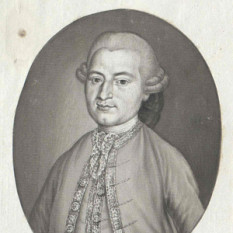Joseph Martin Kraus was a composer in the classical era who is sometimes referred to as "the Swedish Mozart." Kraus was born on June 20, 1756 in Miltenberg am Main, Germany. He moved to Sweden at age 22 and died at the age of 36 on December 15, 1792 in Stockholm.
Bertil van Boer divides Kraus's sacred music into two periods. The first, from 1768 to 1777, comprises Kraus's music written as a Roman Catholic for Catholic services. For the second, from 1778 to 1790, Kraus was still Catholic, but wrote music for Lutheran services. Aside from short hymns and chorales, there was not much use for sacred music in Sweden at that time. There was also a debate going on regarding the role music should play in the church, and Kraus participated in that debate by writing three articles on the subject in the Stockholm Post.
Two different catalogues exist of Kraus's music, one by Karl Schreiber, Verzeichnis der Musikalischen Werke von Jos. Kraus, which gives each composition an A number, and Bertil van Boer's Die Werke von Joseph Martin Kraus: Systematisch-thematisches Werkverzeichnis, which gives each composition a VB number. See the list of compositions by Joseph Martin Kraus.
Bertil van Boer also edited modern editions, on Artaria, of all Kraus's symphonies recorded on Volume 4 of Naxos's complete set of Kraus symphonies, and also wrote the programme notes for those discs as well as the article on Kraus in the New Grove Dictionary of Music and Musicians. Volume 1 won the Cannes Classical Award in 1999, while Volume 2 contains world première recordings of three of Kraus's symphonies. The orchestra Concerto Köln won several prizes for its recordings on period instruments of the complete symphonies of Joseph Martin Kraus.
Kraus' symphonies
A lot of Kraus's symphonies have been lost, or attributed to other composers. Of those which scholars are certain of Kraus's authorship only about a dozen remain. Most of Kraus's extant symphonies are in three movement, without a minuet. Most are scored for two horns and strings, many include two flutes and two oboes, while the later ones also include two bassoons, and two additional horns. The musicologist Bertil van Boer identifies Kraus's Symphony in C♯ minor as "one of only two symphonies in this key written during the eighteenth century." It was later reworked in a more 'manageable' key as Symphony in C minor, VB 142.
It is still a controversial topic if the symphony dedicated to Haydn was Symphony in D major VB 143 or Symphony in C minor VB 142. The minor key and the mood of Symphony VB 142 seem to be a reminiscent of Haydn's "Sturm und Drang" period around 1770, comparable with his earlier minor key works. In any case, Haydn had a very high opinion of the work. Many years after Kraus's death, Haydn remarked to a common friend, Swedish diplomat Fredrik Samuel Silverstolpe:
"The symphony he wrote here in Vienna especially for me will be regarded as a masterpiece for centuries to come; believe me, there are few people who can compose something like that." .
You can find information through the best music search engine - Muzlan.top 😊All materials on request "Joseph Martin Kraus" are available on page Joseph Martin Kraus
Yes of course. You can listen tracks on the page Joseph Martin Kraus
Yes of course. You can download tracks on the page Joseph Martin Kraus
This page is found by queries: Joseph Martin Kraus free download, Joseph Martin Kraus track minus, Joseph Martin Kraus remix, Joseph Martin Kraus song listen, Joseph Martin Kraus mp3 download



